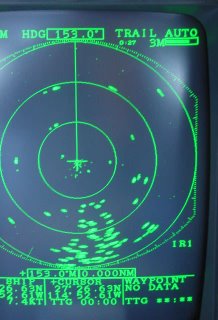
We motoring in the dark is with concern. All is dark except for the instruments. Their colored glows are minimized to maintain night vision. Even the glow of a watch dial can reduce one's night vision. A green glow emanates from the radar, auto pilot and depth finder. The engine gauges are ominously red. We cover the GPS as it's display cannot be reduced sufficiently. Even with these precautions, little is seen looking out the pilot house windows. The radar is essential. We zoom into a 3 mile range and out to 24 miles to see what is coming and what is very close, The gain is adjusted. At a high gain, the screen is filled with dots. As it is decreased, the spurious signals disappear but the smallest craft and buoys stay on the screen. At lower gain settings only the largest signals are left. This process helps us to size our opponents. The most dangerous hazard is a tug pulling a barge as one can end up between the two vessels with disastrous results. On the radar, they appear as two blips moving together, one behind the other. Of course, it could also be one boat following another. The true situation is confirmed by placing a call on the VHF radio to the ship at such and such a latitude and longitude. During this watch a tug put out a VHF call to the vessel at our position advising us of his con configuration, which was a great help. Things did not improve much as the sun rose above the horizon. We were in a thick fog! Every two minutes we would blow the foghorn. As we were approaching the New York harbor area on a holiday, there was a lot of traffic in the fog. IT would help to have an automatic horn that would blow every two minutes. Certain VHF radios can perform this function through their hailing function using an accessory outside speaker.

No comments:
Post a Comment